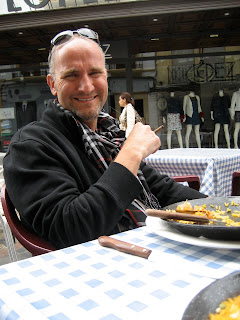








Our last day was spent taking a day trip to Ronda, about 50 km from our hotel. Once we left the coast, we climbed continuously for about 35 km, reaching an altitude of about 5,000 ft. before our decent to Ronda. The route was picturesque and certainly not for those afraid of mountain driving. (Note to Janet O. and Janet J. - this road, which hugged the sheer mountainside, and the one we took the other day from Granada to Marbella, which was marked by frequent and loooong tunnels through the mountains, were described by Molly as "Janet-unfriendly roads" :) And one more comment on the 'creative highway labeling system' in Spain - we had two different maps directing us to Ronda. One told us to take A-336 and one said to take A-376. The actual highway number is A-397. Fortunately it's the ONLY highway to Ronda - but we weren't that lucky driving into Marbella. Aargh.
Ronda is a beautiful old tourist town made famous by bullfighting. Depending on what you read, Ronda claims to have the oldest bullfighting stadium in Spain, built in the late 18th century. The ring is no longer active, but is open to the public for tours with a wonderful museum. Bullfighting had been around for centuries before, but was typically done on horseback. In Ronda, matadors started the current style. Of course, Seville is better known for a more flamboyant style but according to the displays, its fighters do not demonstrate the “authenticity and aplomb” of those from Ronda. Sniff, sniff.
Ronda no longer hosts bullfighting, but as recently as the 1950s, Ernest Hemingway and Orson Welles were residents here and frequented the fights. Both were close friends of Pedro Ordonez who is a national legend in the ring. Senor Ordonez passed away in the late 50s with a claim of killing almost 6,000 bulls without so much as a scratch. Apparently that record has never been matched, not even close. Mr. Welles is buried at Sr. Ordonez's estate here.
Ronda is a very old town and had strategic importance over the millennium. Evidence of Roman viaducts are easy to find. The Moors built a fortress during 11th century and with most things Moorish in Spain, their works were changed to Christian strongholds in the early 16th century. Wandering around the town, you really understand how it was considered an important military asset.
The town is split by a deep gorge. Very, very deep! We found the “new” bridge connecting the two sides (built in the early 17th century). An old bridge was built several centuries earlier. The new bridge is astounding even by modern standards. I doubt anything could be built like it nowadays.
We walked around the bustling market area and settled in at a nice sidewalk café just of a central square for lunch a few beers. Time pretty much stopped and the occasional English overheard just seemed so out of place. The day had started sunny and warm on the coast but it was definitely cooler (low 50s) and cloudy in Ronda. We hit showers heading back over the mountains to Calahonda and the wind had picked up on the coast.
Today was a wonderful, relaxing end to our incredible journey. We’ll have some closing thoughts & photos on our next (and final) blog.
Missing you and will be glad to have you home, but at the same time I wish that you could extend your trip so we could keep enjoying your fantastic blog.
ReplyDeleteThanks, Jan & Don! We're ready to come home, too. T & W
ReplyDelete